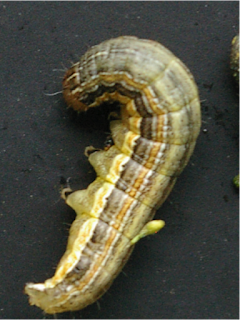Phyllis Bongard, Educational content development and communications specialist
 |
| Western corn rootworm feeding on corn silks |
Know your pests!
Minnesota corn insect pests fall into two broad groups. The first group includes insect pests that can survive our winters, such as corn rootworm and European corn borer. The second group, which includes black cutworms and armyworms, cannot tolerate our freezing winter temperatures and migrate in from the southern U.S.Migratory corn insect pests
The risk of crop damage from these insect pests in 2022 depends not only on the conditions where they overwintered but whether we’ll have the right weather conditions for migration at the right time, according to Potter. The ideal weather pattern for migration involves a high-pressure center to the east and a low to the west, resulting in strong, southerly flows.Once migratory pests arrive, they require good host plants and favorable weather. At least initially, these pest populations tend to be sporadic and localized.
Black cutworm
 |
| Black cutworm damage to young corn plant. Photo: W.M. Hantsbarger, Bugwood.org |
Once the black cutworm moths arrive in Minnesota, they seek out low-lying and weedy areas for egg-laying. Fields with good grass control are less attractive to these moths, reinforcing an advantage of early season weed control. After hatch, small larvae feed on leaves, while 4th and later instar larvae can cut corn up to the 5-leaf stage. Some above-ground Bt traits have some effect on these black cutworm larvae.
During 2021, black cutworm populations were low. The spring was relatively dry with few thunderstorms, conditions that were not conducive for moth migration.
Keep in mind that last year’s situation can’t be used to predict issues this year. You can follow flights and cutworm development in Minnesota this spring on the Black Cutworm Reporting Network.
For more information, see UMN Extension’s Black cutworm webpage or if you’re interested in being part of the trapping network, contact Potter at bpotter@umn.edu.
True and fall armyworms
 |
| True armyworm. Photo: Bruce Potter |
If the fall armyworm (FAW) arrives in Minnesota, it’s usually late in the season. They seldom cause economic loss, although there were some issues in weedy corn fields late last season.
Like the BCW, true armyworm flights into the state can be tracked with light or pheromone traps. A combination of traps, scouting and degree days can help catch these populations before significant crop damage occurs. Armyworms are not as susceptible to above ground Bt traits. For more information, see Armyworm in corn.
Overwintering corn insects
Corn rootworm and European corn borer (ECB) are insect pests that overwinter in Minnesota. Since the adoption of Bt corn hybrids, ECB populations have declined to generally low levels. Corn rootworms, on the other hand, have developed resistance to Bt proteins so they require more complex management.Corn rootworm
A little over 10 years ago, western corn rootworms (WCR) developed resistance to Bt corn. Because of the initial success of Bt corn hybrids, changing management, and an extremely cold winter, populations were significantly reduced for a while. However, corn rootworm populations are now rebounding along with management challenges.Reports of performance issues with Bt-trait pyramids are increasing in WCR populations and northern corn rootworms (NCR) have demonstrated resistance to Bt traits in both North Dakota and Minnesota.
While primarily associated with northern corn rootworms, a variant of the WCR has also developed resistance to crop rotations. Since the WCR is not as winter-hardy, the adaptation involves shifting where the females lay their eggs, including other crops: soybean, small grains, and alfalfa. This WCR "soybean" variant hasn’t been documented in Minnesota yet but has been found in other neighboring (IA, WI) and Great Lake states (IL, IN, MI).
The key to corn rootworm management is knowing what’s in your field and what you want to manage. Different management options provide different solutions, according to Ostlie. For example, soil insecticides may not kill a large percentage of the larvae, so they’re not good at managing resistance, but they are good at reducing lodging and maintaining harvestability.
Bt corn, on the other hand, should give you good root protection and good control in susceptible populations. Since it may be hard to predict the level of resistance in a field, other tools, such as crop rotation, hybrid architecture, and planting date, can also play important roles in managing corn rootworms.
The best way to predict the level of risk for CRW damage is to pay attention to the number of beetles. Fields can then be divided into three groups: 1) Fields to keep a close eye on because they’re borderline, 2) Fields you don’t need to worry about, and 3) Fields with high beetle numbers and potential for significant root injury.
What might we encounter this spring? Conditions were favorable for CRW in 2021 and beetle numbers were high in sticky traps and scouting. The critical question: Did winter mortality occur during the extremely cold temperatures? While corn rootworm densities were already increasing over the past 3 years, the best way to assess risk is to get out and scout. See Scouting for corn rootworm for tips.
Join us for the final webinars
Join us March 16 at 9:00 am when we discuss storing carbon in a production ag system. On March 23, we’ll discuss biocontrol strategies for pests and the final webinar on March 30 will focus on taming fertility and weed management input costs. For more information and to register, visit z.umn.edu/strategic-farming.Thanks to the Minnesota Corn Growers Research and Promotion Council and the Minnesota Soybean Research and Promotion Council for their generous support of this program!
Comments
Post a Comment